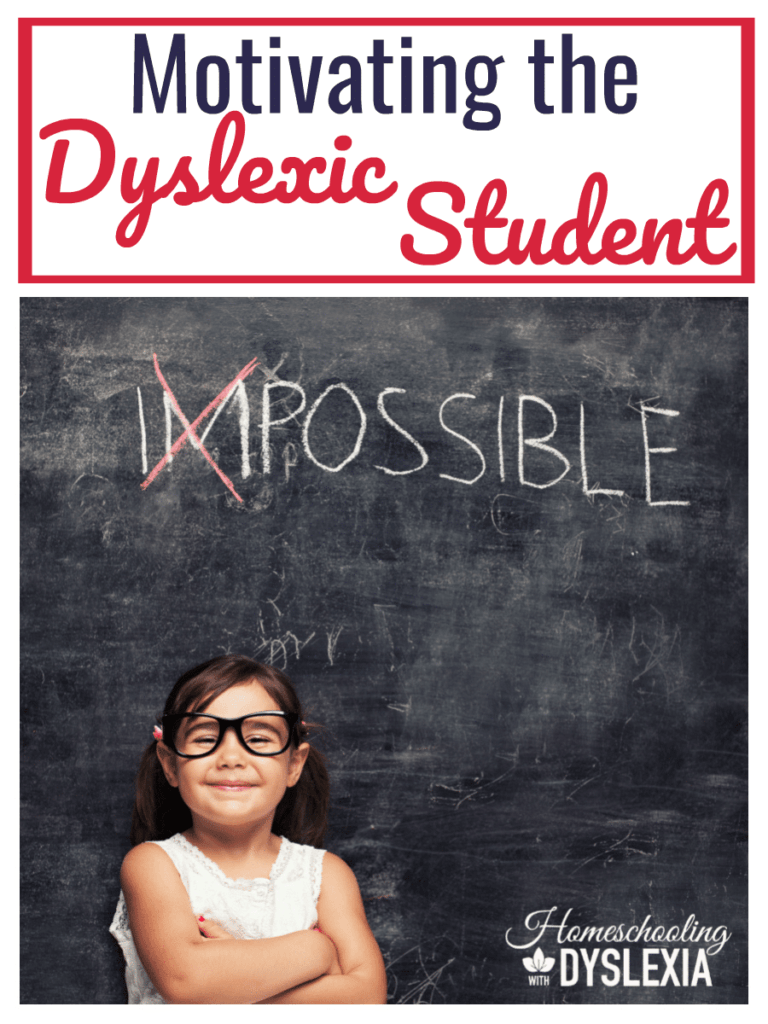Our dyslexic learners can be frustrated in their educational environment. This is why it is so important to work on motivating the dyslexic student. Here are some ways to do that.

Understanding the daily frustrations experienced by the dyslexic learner in their educational environment is critical if you are going to teach them in a way that is motivating.
The challenge in educating a dyslexic student is creating a stimulating and challenging environment for their average to above-average intelligence in spite of their limited reading, writing and spelling skills.
This is accomplished by providing accommodations to the curriculum and learning environment for dyslexic learners.
What are Accommodations?
Accommodations are alterations to the curriculum or to the learning environment that allow a student to perform to their cognitive ability. We wouldn’t ask someone in a wheel chair to climb a stairway to get to class nor would we ask a blind student to take a test that was not administered in Braille. Providing accommodations to a dyslexic student, levels the playing field and allows that student to exercise and strengthen their higher level thinking skills without being constrained by their handicap of slow, inaccurate reading.
If teaching time is continually spent trying to pound a square peg into a round hole by stubbornly clinging to the use of traditional teaching methods, our dyslexic kids will essentially be doing reading comprehension exercises all day long, become bored and burnt out and over time be defined by their inability – allowing the continual frustration of daily school work to lead to discouragement.
Homeschool or Public School
Accommodations will look a lot different depending on where your student goes to school. Public schooled students will need to go through the administration of their school to get the appropriate testing and official 504 plan that allows their student to have accommodations in the classroom. My book, Dyslexia 101, has a complete chapter on navigating the public school system.
For homeschooled kids there is freedom to teach according to your child’s learning style and modifying your curriculum to allow them to learn without being hindered by their reading weakness.
Accommodations That Work
Maintain daily routines.
Provide a quiet, uncluttered work space. I know. In a houseful of kids these is easier said than done.
Use graphic organizers for organizing thoughts. Tap into those visual strengths.
Use of technology for note taking, writing (speech-to-text) or reading (text-to-speech). See my list of favorites, {here}.
Allow the use of audio books. Visit LearningAlly.org for access to thousands of books (including textbooks) in a digital format.
Provide for extra review. Dyslexic students need more time to process what they learn.
Provide extra time for tests. Dyslexic students, no matter how much remediation they receive, still read and process the written word more slowly than non-dyslexics.
Read test questions out loud to student. We want to know how much they know, right? Save the reading comprehension tests for their language arts instruction.
Allow oral answers rather than written. Because of difficulties with spelling and writing, dyslexics often don’t express themselves nearly as well when communicating via the written word.
Allow more time for processing both written assignments and oral instructions. Explain a concept and give them time to take it all in (processing) before moving ahead to the next concept.
Consider obtaining a waiver for the high school foreign language requirement. Many colleges waive the foreign language requirement for students with learning disabilities.
The dyslexic students’ best mode of learning is through meaning; meaning provides a framework for remembering. More than for others, they must fully understand the topic; rote memory does not work well for them. Focus on concepts and real-life examples and experiences, and provide many opportunities for practice. Teach ideas first, then establish categories for different groups of facts, and point out connections within and between categories.
The struggles that dyslexic students have stem from a difficulty in processing the written language that compromises their ability to learn efficiently from reading. Teaching reading, writing and spelling is important and cannot be neglected in the education of a dyslexic child. We must continue to remediate their language-based weaknesses while at the same time accessing the dyslexic’s average to above-average higher-level thinking and reasoning skills.
For a closer look at how we teach our dyslexic students at home and how we provide accommodations to their curricula and learning environments with the use of audio resources, oral work and other outside the box methods, read my series called Homeschooling With Dyslexia: By the Subject.








Do you have any suggestions for encouraging and motivating my son who has a sister 2 years younger and is one level ahead in our reading curriculum (All About Reading). I teach them separately. There are days when he really gets down on himself and that can set the path for reading lessons for a few days.
Here is a post I wrote on that!
https://dev.homeschoolingwithdyslexia.com/help-my-first-grader-reads-better-than-my-fourth-grader/